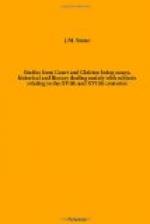From the moment that she set foot in Scotland, as a bride of thirteen, she began to sow discord; but although it was soon apparent that she would seize every occasion to turn public events to her own profit, James iv. had so mistaken a belief in her one day becoming a good Scotswoman, that when he went to his death on Flodden Field, he left the whole welfare of his country in her hands. Not only did he confide the treasure of the realm to her custody, but by his will he appointed her to the Regency, with the sole guardianship of his infant son.
Such a thing was unprecedented in Scotland, and it needed all the fidelity of the Scottish lords to their chivalrous sovereign, as well as their enthusiasm for his young and beautiful widow, to induce them to tolerate an arrangement so distasteful to them all. Had Margaret cared to fit herself for the duties that lay before her, her lot might have been a brilliant one. Instead of the wretched wars which made a perpetual wilderness of the Borders, keeping the nation in a constant state of ferment, an advantageous treaty would have secured prosperity to both England and Scotland, while the various disturbing factions, which rendered Scotland so difficult to govern by main force, would gradually have subsided under the gentle influence of a queen who united all parties through the loyalty she inspired. Fierce and rebellious as were so many of the elements which went to make up the Scottish people at that time, Margaret had a far easier task than her grand-daughter, Mary Stuart, for at least fanatical religious differences did not enter into the difficulties she had to encounter. But such a queen of Scotland as would have claimed the respect and won the lasting love of her subjects was by no means the Margaret Tudor of history, as she stands revealed in her correspondence.
While James iv. lived she had comparatively few opportunities of betraying State secrets, but from the disaster of Flodden to her death, her history is one long series of intrigues, the outcome of her ruling passions—vanity and greed. Her first short-sighted act of treachery after the death of James was to appropriate to her own use the treasure which he had entrusted to her for his successors, the queen thereby incurring life-long retribution in her ineffectual attempts to wring her jointure from an exchequer which she had herself wantonly impoverished. Hence the tiresome and ridiculous wrangling in connection with her “conjunct feoffment,” neither Margaret nor Henry being conscious, in the complete absence of all sense of humour on their part, that the situation was occasionally grotesque. Stolidly unmindful of the effect they produced on the minds of others in the pursuit of their own selfish ends, they pursued the tenor of their way with bucolic doggedness. The doggedness ended in the defeat of all Henry’s enemies; in Margaret’s case it ended in her own.




